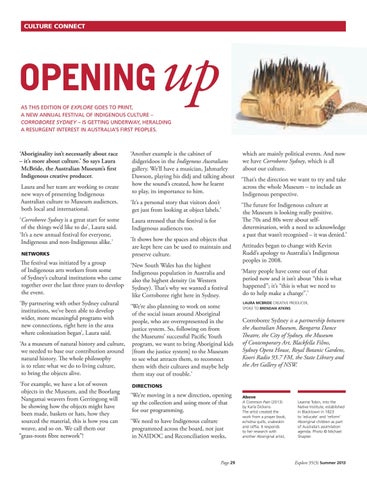CULTURE CONNECT
OPENING
up
AS THIS EDITION OF EXPLORE GOES TO PRINT, A NEW ANNUAL FESTIVAL OF INDIGENOUS CULTURE – CORROBOREE SYDNEY – IS GETTING UNDERWAY, HERALDING A RESURGENT INTEREST IN AUSTRALIA’S FIRST PEOPLES.
‘Aboriginality isn’t necessarily about race – it’s more about culture.’ So says Laura McBride, the Australian Museum’s first Indigenous creative producer. Laura and her team are working to create new ways of presenting Indigenous Australian culture to Museum audiences, both local and international. ‘Corroboree Sydney is a great start for some of the things we’d like to do’, Laura said. ‘It’s a new annual festival for everyone, Indigenous and non-Indigenous alike.’ NETWORKS
The festival was initiated by a group of Indigenous arts workers from some of Sydney’s cultural institutions who came together over the last three years to develop the event.
‘Another example is the cabinet of didgeridoos in the Indigenous Australians gallery. We’ll have a musician, Jahmarley Dawson, playing his didj and talking about how the sound’s created, how he learnt to play, its importance to him. ‘It’s a personal story that visitors don’t get just from looking at object labels.’ Laura stressed that the festival is for Indigenous audiences too. ‘It shows how the spaces and objects that are kept here can be used to maintain and preserve culture. ‘New South Wales has the highest Indigenous population in Australia and also the highest density (in Western Sydney). That’s why we wanted a festival like Corroboree right here in Sydney.
‘By partnering with other Sydney cultural institutions, we’ve been able to develop wider, more meaningful programs with new connections, right here in the area where colonisation began’, Laura said.
‘We’re also planning to work on some of the social issues around Aboriginal people, who are overrepresented in the justice system. So, following on from the Museums’ successful Pacific Youth ‘As a museum of natural history and culture, program, we want to bring Aboriginal kids we needed to base our contribution around [from the justice system] to the Museum natural history. The whole philosophy to see what attracts them, to reconnect is to relate what we do to living culture, them with their cultures and maybe help to bring the objects alive. them stay out of trouble.’ ‘For example, we have a lot of woven objects in the Museum, and the Boorlang Nangamai weavers from Gerringong will be showing how the objects might have been made, baskets or hats, how they sourced the material, this is how you can weave, and so on. We call them our “grass-roots fibre network”!
which are mainly political events. And now we have Corroboree Sydney, which is all about our culture. ‘That’s the direction we want to try and take across the whole Museum – to include an Indigenous perspective. ‘The future for Indigenous culture at the Museum is looking really positive. The 70s and 80s were about selfdetermination, with a need to acknowledge a past that wasn’t recognised – it was denied.’ Attitudes began to change with Kevin Rudd’s apology to Australia's Indigenous peoples in 2008. ‘Many people have come out of that period now and it isn’t about “this is what happened”; it’s “this is what we need to do to help make a change”.’ LAURA MCBRIDE CREATIVE PRODUCER, SPOKE TO BRENDAN ATKINS
Corroboree Sydney is a partnership between the Australian Museum, Bangarra Dance Theatre, the City of Sydney, the Museum of Contemporary Art, Blackfella Films, Sydney Opera House, Royal Botanic Gardens, Koori Radio 93.7 FM, the State Library and the Art Gallery of NSW.
DIRECTIONS
‘We’re moving in a new direction, opening up the collection and using more of that for our programming. ‘We need to have Indigenous culture programmed across the board, not just in NAIDOC and Reconciliation weeks,
Page 29
Above A Common Pain (2013) by Karla Dickens. The artist created the work from a prayer book, echidna quills, snakeskin and raffia. It responds to her research with another Aboriginal artist,
Leanne Tobin, into the Native Institute, established in Blacktown in 1823 to ‘educate’ and ‘reform’ Aboriginal children as part of Australia’s assimilation agenda. Photo © Michael Shapter.
Explore 35(3) Summer 2013
















